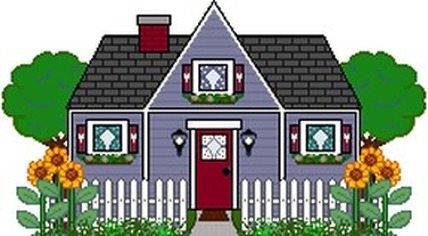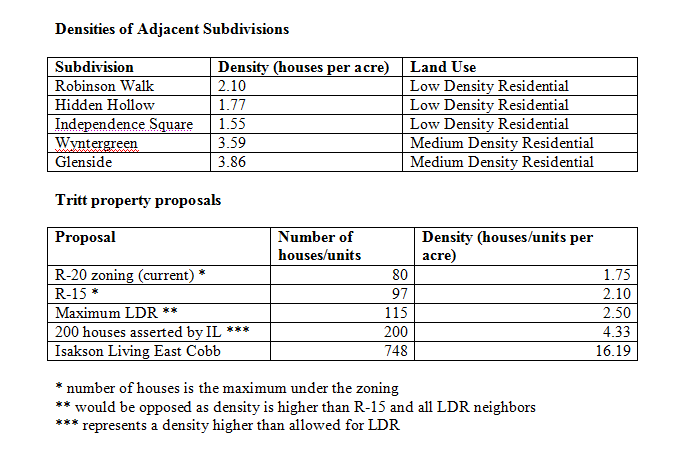
The land is Low Density Residential (LDR) on Cobb County's Future Land Use map, and that is not going to change. Changes to the Future Land Use map happen far less frequently than changes in zoning. Low Density Residential means a density of no more than 2.5 units (houses) per acre.
The land is currently zoned R-20, meaning each lot has a minimum of 20,000 square feet.
The Tritt property is 53.7 acres, of which 7.5 acres is floodplain, leaving 46.2 acres not in the floodplain. Floodplain and wetlands cannot be built on, and are not allowed in overall density calculations for a development.
At the current zoning of R-20, a maximum of 80 houses could be built, since R-20 has a maximum average density of 1.75 houses per acre. The R-15 zoning, which allows minimum lots sizes of 15,000 square feet, has a maximum average density of 2.1 houses per acre, meaning that a maximum of 97 houses could be built at R-15.
If houses were built at 2.5 houses per acre, which is the maximum density for Low Density Residential, that would yield 115 houses. However, that would require some of the property to be zoned RA-5, and the rest R-15. RA-5 represents a range of densities, from 2.5 to 5.0 units per acre, and is limited by code to 20 acres maximum. We would vigorously oppose any RA-5 zoning, even partial, on the Tritt property. All proposals for development on the Tritt property will be judged on their own merits, but RA-5 is a non-starter.
So, 115 houses is the maximum number of houses that could be built, since the property is Low Density Residential, but we would oppose this many houses, because it means a zoning more dense than R-15, which would allow a maximum of 97 houses. The topography of the property, including steep areas, and several acres of floodplain and stream buffers which cannot be cleared, may mean that actually fewer than 97 houses could be built.
Isakson Living asserts that 200 houses could be built on the property, which represents a density of 4.33 houses per acre (200 divided by 46.2 acres). This is a significantly higher density than any of the adjacent subdivisions, and would not be allowed on Low Density Residential land, which again has a maximum density of 2.5 houses per acre.
The Tritt property does adjoin two subdivisions for part of its east side which are on Medium Density Residential (MDR) land. These two subdivisions have densities of 3.59 and 3.86 houses per acre, which is allowable in Medium Density Residential (up to 5.0 houses per acre). These two subdivisions are both zoned RA-4, a zoning which is no longer used for new developments, and which allowed up to 4 houses per acre. Comparing the Tritt property to these MDR subdivisions is comparing apples to oranges, since the Tritt property is LDR.
The two LDR subdivisions that adjoin the Tritt property, Robinson Walk and Hidden Hollow, have densities of 2.10 and 1.77 houses per acre respectively. The Independence Square subdivision, which is not directly adjacent the Tritt property, but is just to the north, across Roswell Road and behind a row of low-rise office buildings, has a density of 1.55 houses per acre.
The Tritt property can be compared to the adjacent and nearby LDR subdivisions, since the Tritt property itself is LDR. The latest Isakson Living East Cobb proposal has 748 units, which means a density of 16.19 units per acre. This is over 7 times as dense as the densest adjacent LDR subdivision, and over 4 times as dense as the densest adjacent subdivision (which is on MDR land).
Isakson Living's assertion that 200 houses could be built on the Tritt property is incorrect, because that represents a density of 4.33, which is in the Medium Density Residential range, and would require changing the property from LDR to MDR, and the chances of that happening are very low. Under the current LDR land use, the property could have 115 houses maximum, and that would be contested because it represents a density greater than the R-15 zoning allows, and greater than all the LDR neighbors. 97 is the maximum number of houses that could be built if the zoning were changed to R-15, and we believe that is the maximum realistic number of houses on the property.


 RSS Feed
RSS Feed